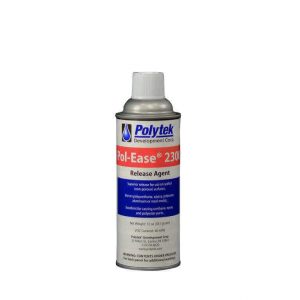You may need sealers and/or release agents for casting molds or models.
Sealers
A sealer fills small holes and imperfections so that liquid casting material does not get stuck in it. Filling these holes, of the pores, ensures that no rubber sticks or sucks on the mold or surface. A sealer is not necessary in all cases, but a release agent is much more regular. Always apply the sealer before the release agent. There are 3 types of sealers; permanent, semi-permanent and removable. Permanent ones are applied once, semi-permanent and removable ones need to be reapplied more often. Please note that too much use of a sealer can reduce or affect the quality of the mold.
Lossingsmiddelen
Release agents are coatings that you apply to ensure that liquid rubbers and resins do not stick to surfaces. There are 2 types of release agent: for making molds and for casting models. A release agent can almost always be used for both applications. If you are going to make a choice from release agents, you must check whether these are necessary for the application. Plaster, various waxes and some concrete mixes can be poured into polyurethane and silicone molds without release agent. In almost all cases you can pour into silicone molds without release agent. As a rule, polyurethane adheres to polyurethane or other products. You often have to use a release agent with a polyurethane product such as a resin, rubber or foam. With a silicone on silicone mold, we recommend that you first do a test or use a release agent. With silicone on silicone it may be that they stick to each other.
Below is an overview of the most common sealers and release agents.
| Schouten SynTec® Product | Sealer |
Release agent |
Use on models or in molds | Description |
| Poly PVA Solution | ✓ | ✓ | Both | Water-soluble sealer and release agent for alcohol-based porous models. Available in green or transparent. Applicable to models that will be used with liquid polyurethane and silicone rubbers. Only applicable with polyurethane moulds. |
| Pol-Ease® 2350 Sealer & Release Agent | ✓ | ✓ | Only for models | White Vaseline dissolved in mineral water. A semi-permanent sealer/release agent. Applicable to models that use liquid polyurethane and silicone. |
| PolyCoat Sealer & Release Agent | ✓ | ✓ | Both | Semi-permanent silicone-based sealer/release agent. Applicable to models using polyurethane and platinum (addition) cured silicone rubber (not recommended for tin (condensation) cured silicone rubber). Applicable to molds of polyurethane, platinum cured silicone and tin cured silicone. |
| Pol-Ease® 2300 Release Agent | X | ✓ | Both | Aerosol release agent spray on a silicone basis for use on non-porous or sealed models. Only to be used with polyurethane rubber. |
| Pol-Ease® 2450 Release Agent | X | ✓ | Both | Silicone-based release agent. Applicable to models that use liquid polyurethane rubber. Dries quickly, but flammable. Applicable to cured polyurethane molds. |
| Pol-Ease® 2500 Release Agent |
X |
✓ | Both | Aerosol spray release agent that can be washed off models and moulds. Ideal for when a model needs to be treated afterwards (painting, spraying). Applicable for models that use liquid silicone rubbers, but not recommended for liquid polyurethane rubbers. Applicable to molds made of cured polyurethane and silicone rubber, but can have an effect on the life of the polyurethane. |
| Pol-Ease® 2601 Release Agent | X | ✓ | Only in cured molds | Water-based release agent to be used before pouring concrete or plaster. Only to be used with polyurethane moulds. |
| Pol-Ease® 2650 Release Agent | X | ✓ | Only in cured molds | Oil-based silicone-free release agent for use when pouring concrete or plaster. Only to be used with cured polyurethane moulds. |
Schouten SynTec has the following common release agents:
Pol-Ease 2300

Pol-Ease 2300 must be carefully washed off the model with water and detergent or a citrus degreaser before it can be processed. If you still have trouble cleaning, PolyCoat or Pol-Ease 2500 is a good alternative.
Pol-Ease 2500

A release agent that is offered in aerosol cans. Pol-Ease 2500 is used to treat sealed and non-porous models before applying a liquid silicone rubber. The application of a release agent is usually not necessary for the addition of silicone, but Pol-Ease 2500 offers extra security in this process. There are silicone products that adhere to each other.
To improve longevity, spray and brush Pol-Ease 2500 into the silicone mold when using molding materials such as polyurethane plastic, rubber or epoxies. Using Pol-Ease 2300 improves the service life better than using Pol-Ease 2500. The main reason why Pol-Ease 2500 would be used in a polyurethane mold is because models are much easier to clean. For example, when a polyurethane resin or rubber has to be painted.

